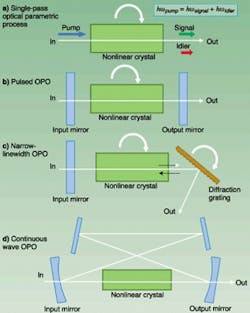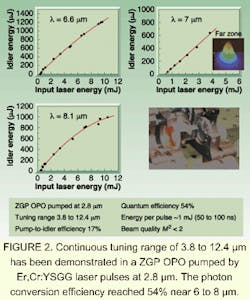OPOs target the longwave infrared
KONSTANTIN L. VODOPYANOV
The advent of new nonlinear-optical materials as alternatives to the traditional oxides and silver-containing compounds has allowed development of compact and efficient optical parametric oscillators with infrared tunability extending far beyond 5 µm. This has opened up new applications in molecular spectroscopy, atmospheric monitoring, and ultra-sensitive detection.
The 2- to 20-µm portion of the mid-infrared (mid-IR) region of the spectrum is the so-called "molecular fingerprint" region in which gases and vapors exhibit their fundamental absorption features. If humans could see light at frequencies three or four octaves below the usual visible region of the spectrum and if they could visualize an extended set of "colors" (mid-IR-blue, mid-IR-green, and so on), the air around us would appear vibrantly colorful. We would see our colleagues exhaling mid-IR-orange-colored carbon dioxide, leaves decaying in the yard surrounded by a thin veil of mid-IR-green methane, and nearly black water vapor drifting everywhere.
Pollution monitoring, atmospheric chemistry, and chemical and biological warfare detection can benefit from compact and efficient mid-IR laser sources that allow detection of trace gases and vapors by volume, down to the part-per-billion level. Other applications of tunable mid-IR coherent sources include noninvasive medical diagnosis by breath analysis, ultrasensitive detection of drugs and explosives down to the part-per-trillion level using cavity ring-down spectroscopy, and short-range terrestrial or near-earth communications.
Optical parametric oscillators (OPOs) are the laser sources of choice if high peak or average power, high conversion efficiency, and broad continuous tunability (more than one octave) are required. They play a particularly important role in the mid-IR (Δ >2.5 µm) where there is a lack of tunable lasers similar to Ti:sapphire or alexandrite, both of which operate in the near-infrared.
An OPO converts monochromatic laser emission (pump) into a tunable output via a three-wave mixing process. Quantum efficiencies can exceed 50%. The heart of an OPO is a nonlinear-optical (NLO) crystal characterized by an NLO coefficient, deff, and related NLO figure of merit, deff2/n3, (where n is the refractive index). In the NLO crystal, the pump photon decays into two less-energetic photons (signal and idler) so that the sum of their energies is equal to that of the pump photon. An important further constraint is that the sum of the signal and idler wave-vectors must equal that of the pump ("phase-matching" condition). The latter condition is never satisfied in the transparency range of isotropic media but can be fulfilled in birefringent crystals. Alternatively, it can be fulfilled in quasi-phase-matched (QPM) crystals with periodically modulated nonlinearity (periodically poled lithium niobate, for example) in which the artificially created grating compensates for the wave-vector mismatch.
Parametric frequency down-conversion in an OPO can be regarded as the inverse process of sum-frequency generation. Alternatively, an NLO crystal can be viewed simply as a catalyst that promotes decay of the pump photon into two smaller photons. Rotating the crystal changes the ratio between the signal and idler photon energies, and thus tunes the frequency of the output. The easiest way to illustrate the parametric frequency conversion is to consider the case of a short (<1 ns) intense pulse as the pump. In this case, a single pass through an NLO crystal is sufficient to convert a substantial fraction (>10%) of the pump into the signal and the idler (see Fig. 1). This type of single-pass device is called an optical parametric generator (OPG). For pump pulses with lower intensity, parametric frequency conversion is weaker; therefore, a resonator OPO cavity is required to enhance this process. To achieve a narrow linewidth, a diffraction grating can be incorporated into the cavity—and when a continuous-wave (CW) pump is used and tight focusing is necessary, a four-mirror ring OPO cavity can be used with two flat and two concave mirrors.New 'old' birefringent materials
The longwave transmission cutoff of traditional nonlinear optical materials such as lithium niobate (LiNbO3), potassium titanyl phosphate (KTP), lithium borate (LBO), beta-barium borate (BBO), periodically-poled LiNbO3 (PPLN), and periodically-poled KTP (PPKTP) has limited the tuning range of existing commercial OPOs to 4 µm. Silver-containing chalcopyrites have extended the tuning range up to 11 µm (AgGaS2 with a 1.06-µm pump) and 14 µm (AgGaSe2 with a 1.57-µm pump).1, 2 The relatively low optical nonlinearity, low thermal conductivity, and susceptibility to surface degradation resulting from a low laser-damage threshold severely limit the practical application of AgGaS2 and AgGaSe2, however.
Three birefringent crystals—the chalcopyrites ZnGeP2 (ZGP) and CdGeAs2 (CGA), and the layered chalcogenide GaSe—exhibit huge optical nonlinearities, deep-IR transparency, high thermal conductivity, and high laser-damage thresholds (>1 J/cm2). First explored as nonlinear optical materials in the early 1970s, ZGP, GaSe, and CGA crystals were too small and exhibited poor optical uniformity and large absorption. Three independent crystal-growth groups—Siberian Physico-Technical Institute/ Institute of Atmospheric Optics (Tomsk, Russia), BAE Systems (Nashua, NH), and Inrad Inc. (Northvale, NJ)—now can grow ZGP, GaSe, and CGA crystals of usable size (more than 20-mm long) with extremely low absorption (typically 0.01 cm-1) in the middle of their transparency range.
One of the remarkable breakthroughs in mid-IR OPO technology was the demonstration of the broadband ZGP OPO with more than 10 W of output power at 3 to 5 µm (signal plus idler), and more than 50% efficiency.3 The OPO was pumped with a 20-W diode-pumped, Q-switched (10-kHz, 11-ns) thulium-holmium-doped YLF laser at 2.05 µm, and the ZGP crystal was 14-mm long. Later on, an impressive continuous tuning range from 3.8 to 12.4 µm was demonstrated in a ZGP OPO pumped by 100-ns erbium-laser pulses at 2.9 µm.4 The OPO had a very low pump threshold (0.3 MW/cm2) and a linewidth of less than 1 cm-1. The observed photon conversion efficiency reached 46%, but higher efficiencies of 54% have been measured since with an erbium-chromium-doped YSGG (Er,Cr:YSGG) laser pump at 2.8 µm (see Fig. 2).The chalcogenide GaSe has an exceptionally wide transparency range and high second-order nonlinearity (NLO figure of merit is 5 times that of PPLN). Its main drawback is that it is a soft-layered material that can be cleaved only along the 001 plane. Due to the very large birefringence of GaSe (Δn ~0.35), however, it can satisfy phase-matching conditions for most of the three-wave processes within its transparency region. Most important is that a GaSe OPO can, in theory, be pumped by a 1.06-µm laser—but such an OPO has not been demonstrated yet, partly because of the problems associated with the AR coating of the crystal.
To improve mechanical properties of GaSe crystals, a group at Northrop Corp. (Pittsburgh, PA) has grown GaSe doped with indium. It has shown that doping with low levels of indium greatly improves the GaSe mechanical properties but does not alter the intrinsic value of the NLO coefficient.5 Since an OPG, as compared to an OPO, does not need mirrors and AR coatings are not crucial, it was comparatively straightforward to use GaSe in an OPG scheme in which single 100-ps, 2.8-µm Er,Cr:YSGG laser pulses served as the pump. The tuning range of 3.3 to 19 µm, the largest of any mid-IR parametric device, has been demonstrated with quantum conversion efficiency of 5% (see Fig. 3).6Considered the "Holy Grail" of infrared NLO materials because of its enormous second-order nonlinearity (236 pm/V), CGA has proven effective for numerous NLO mid-IR applications, in particular for SHG of CO2 lasers and efficient (up to 20%), continuously tunable (6 to 20 µm) difference-frequency generation. A CGA OPO has not been demonstrated yet, because it lacks an appropriate pump-laser source (it needs a pump wavelength greater than 3 µm). The first CGA-based subpicosecond OPG has been reported recently, however: when a single-pass CGA OPG was pumped by 10-µJ, 600-fs pulses at 5 µm, its output was tunable, via angle-tuning, in the 7- to 18-µm range.7
Exploring quasi-phase-matched materials
Gallium arsenide (GaAs) is a crystal with low optical losses, high optical nonlinearity (90 pm/V), superior thermal conductivity, and a large surface-damage threshold. Growth of GaAs is a mature technology, and the only obstacle preventing GaAs from serving as an ideal mid-IR NLO material is that its cubic crystal structure lacks birefringence.
In order to achieve quasi-phase-matching in GaAs, researchers at Stanford University (Stanford, CA) and Thomson CSF (Orsay, France) fabricated all-epitaxial GaAs structures with domains of inverted sign of NLO coefficient. Films of orientation-patterned GaAs, 200-µm thick and 4.6-mm long, with domain periods of 27 or 212 µm, were grown by hybrid vapor-phase epitaxy on orientation-patterned GaAs substrates.8 The substrate was prepared with a process using molecular-beam epitaxy, photolithography, and wet-chemical etching. The 200-µm-thick QPM GaAs samples are thick enough for bulk NLO applications: for instance, a CO2-laser beam can be focused into it. The effective NLO coefficient (48 pm/V) extracted from SHG experiments with a CW CO2 laser was found to be close to theoretical (57 pm/V) in such a QPM GaAs sample. Quite recently, 500-µm-thick and 1-cm-long QPM GaAs samples have been demonstrated by the same team.
Practical and expanding applications
A direct comparison can be made between ZGP, CGA, GaSe, and GaAs as OPO materials from the viewpoint of their spectral performance (see Fig. 4).Despite the fact that ZGP has a comparatively narrow transparency range, ZGP OPOs serve as the workhorse in many mid-IR OPO applications in which high average power or broad tunability are required because the crystal is robust. For example, a broadly tunable ZGP OPO was used at Informed Diagnostics Inc. for ultrasensitive vapor detection. The first spectroscopic detection of explosives (TNT and RDX) using cavity ring-down spectroscopy has been achieved via absorption measurements in their fundamental bands between 6 and 8 µm.9
The best choice for longwave applications seems to be CGA, which is expected to have the smallest OPO pumping threshold due to its highest NLO coefficient. It needs a suitable pump source, however, such as the 3- to 3.5-µm output of an Nd:YAG-laser-pumped PPLN OPO. In contrast, a GaSe OPO can be pumped directly by a 1.06-µm laser and can deliver continuous tunability of 1 to 18 µm, provided that the AR-coating and mechanical-hardness problems are solved. Even though it is still at a research level, QPM GaAs is attractive in many senses for future spectroscopic applications: it can be pumped at 1 µm and has broad transparency (1 to 18 µm). An OPO based on QPM GaAs can be pumped at very low levels since there is no birefringent walk-off in the crystal, and the pump beam can be focused very tightly.
Major progress in creating advanced NLO materials has enabled efficient, high-power, broadly tunable optical parametric devices for the mid-IR range of the spectrum. New challenges include further development of artificial QPM materials (such as GaAs, ZnS, ZnSe), and progress toward compact all-solid-state mid-IR OPO devices based on diode-pumped laser technology.
REFERENCES
- K. L. Vodopyanov et al., Appl. Phys. Lett. 75, 1204 (1999).
- S. Chandra et al., Appl. Phys. Lett. 71, 584 (1997).
- P. Schunemann, Laser Focus World, April 1999, p. 85.
- K. L. Vodopyanov et al., Opt. Lett. 25, 841 (2000).
- D. R. Suhre et al., Opt. Lett. 22, 775 (1997).
- K. L. Vodopyanov, J. Opt. Soc. Am. 16, 1579 (1999).
- K. L. Vodopyanov et al., CLEO 2001, paper CThD4.
- L. A. Eyres et al., CLEO 2000, paper CFN3.
- T. G. Owano et al., CLEO 2001, paper CThT1.
Konstantin L. Vodopyanov is director of mid-infrared systems at Informed Diagnostics Inc., 1050 E. Duane Ave, Suite H, Sunnyvale, CA 94085; email: [email protected].



